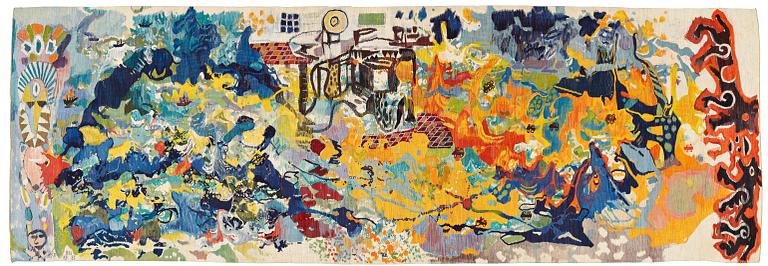Sven X:et Erixson
A TAPESTRY, tapestry weave, after a cartoon by the Swedish painter Sven X:et Erixson, translated into a weave by Barbro
Nilsson, ca 143 x 407 cm. A polychrome modernistic composition. The painter Sven X:et Erixson executed the cartoon for this tapestry in 1960-61. The tapestry was woven for Margarinbolagets head office, Stockholm, (Strandbergsgatan 20). A label comes with this lot: Vävd efter kartong av Sven Erixson på Barbro Nilssons verkstad N. Smedjegatan 21, Stockholm, av Kerstin Fredrikson och Edith Johansson 1961-1962. (Unique).
Slightly dirty, insignificant wear and faded, minor stains and damages.
Literature
Compare with Konstrevy 1961, Stockholm 1961, Prydnad för kontor, text pages 144-145 and 160, plate page 144; Möller, Viggo Sten: En bok om Barbro Nilsson, Stockholm/Barcelona 1977, text page 100.
More information
Sven X:et Erixson has made several cartoons for tapestries that have been translated into a weave by Barbro Nilsson. The most famous is "Melodier vid torget" for Gothenburg's concert hall.
Designer
Sven Erixson, today more commenly known as X, was born in 1899 in Stockholm. He studied to become a decoration painter and art teacher at the Technical School in Stockholm after which he studied at the Higher School of Art and Design alongside study trips to Germany, France, Italy, Spain and North Africa. Despite being an inportant artist amoungst Swedish art, Erixson does not let etiquette and style limit his painting style. His greatest creation is defined by a tempremental style in stark colour patterns. Erixson's paintings balances between impressive, somewhat brutal expressions and a soft lyricism. He is one of the founders of the group Färg och Form, whose primitivist faction he belonged to. With an aura of narrative joy, Erixson recounts his experiences. He had an irresistable desire to share everything that he saw. He was inspired, much like Bror Hjorth of both folk art and mural painting from the middle ages, while also finding inspiration from German expressionism. But he speaks with greatest esteem about Chaim Soutines art. In a multitude of paintings, he conveyed his zest for life, with surfaces filled with swiftly captured figures. During the 1930s, his visual world was filled with family and the idyllic torpor, his canvas became greater and more complete. During the war he painted on butter paper, not only for practicalities sake, but also to take advantage of the slippery reflective surface which the paper supplies. Narration decreased in the 1950s when he was influenced by spontaneity, which in the following years led him to abstract spontaneous painting.
Read more
















































